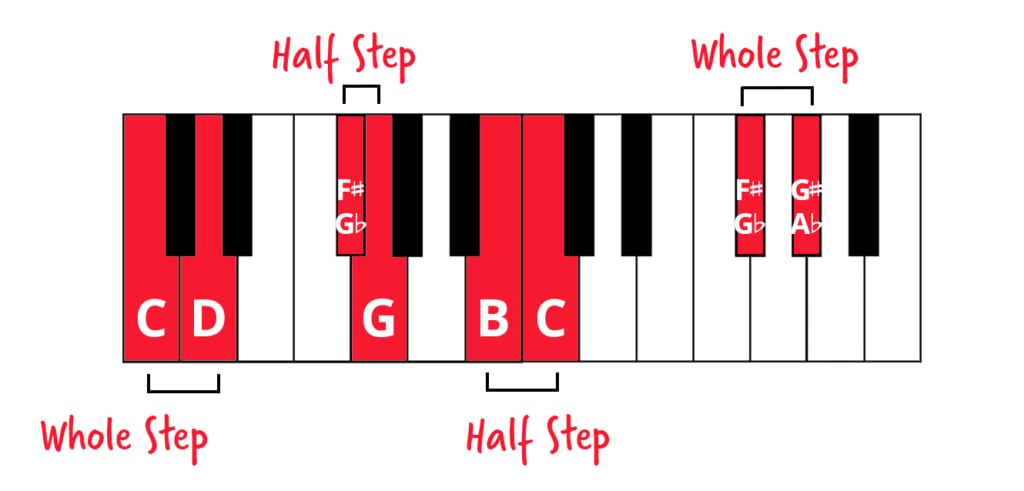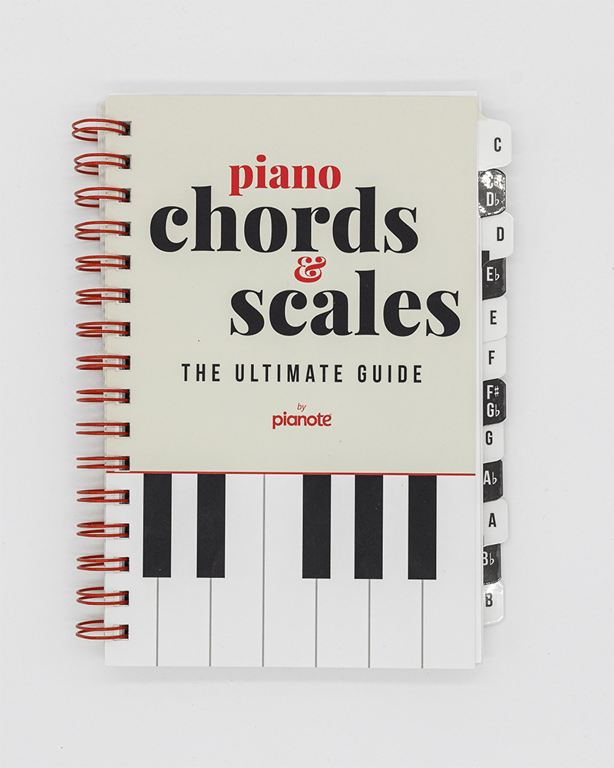
Piano scales are one of the first things you learn as a beginner piano player, but why are they so important?
Well, playing your C major scale up and down isn’t just about practicing your technique; scales are a foundational musical concept. Understanding scales means you’ll understand key signatures and chords, which form the building blocks of Western music.
In this post, we’ll discuss why scales are important, break down the different types of scales, and show you ways to apply these scales to your piano playing.
Table of Contents
Get exclusive interviews, fascinating articles, and inspiring lessons delivered straight to your inbox. Unsubscribe at any time.
According to Wikipedia, “a scale is any set of musical notes ordered by fundamental frequency or pitch.”
Here’s a simpler definition that I like:
“A series of notes arranged in an order according to specific rules.”
The fundamental scales every piano player should know are the major and minor scales. Pianists who want to play rock, blues, pop, and jazz should also learn the pentatonic and blues scales. Finally, jazz uses even more scales, such as modes, bebop scales, and whole tone scales.
Piano scales are often associated with technique. And while it’s true that practicing your scales will help you play faster and more smoothly, scales are important for understanding theory, too. Practicing scales helps us understand concepts like key signature (how many sharps and flats there are in a key).
Piano scales also help piano players improvise! For example, you can use any note from the C major scale to improvise on top of a chord progression in C major. Blues and pentatonic scales are also popular tools to improvise with.
We must also understand that scales and chords are closely related. Every scale has a strong relationship with a chord. Scales and chords “imply” each other. For example, C Mixolydian and C7 share many similarities. So, knowing what scale is related to what chord will help you improvise over that chord.
Many students find piano scales tedious to practice. That’s why we at Pianote love creating practice routines that are fun, musical, and engaging. Here are a few:
Now that we know what scales are and why they’re important, let’s explore some in ascending order of difficulty. We’ll start with the scales every piano player should know regardless of the style of music they play: major and minor scales.
Major scales sound “happy” and you may recognize them as the do-re-mi scale. These are the first scales you should learn. All major scales follow the same formula of whole and half steps: W-W-H-W-W-W-H. Half-steps are when two keys on the piano are right next to each other, while whole steps have a key in between. Here are some examples of whole and half steps:

The notes of a scale are called scale degrees. Major scales have seven degrees and they each have a name: tonic, supertonic, mediant, subdominant, dominant, submediant, and leading tone. You may hear scale degrees and degree names mentioned when musicians talk about diatonic chords.
Here are the 12 major scales:
C Major
Notes: C-D-E-F-G-A-B-C

D Major
Notes: D-E-F♯-G-A-B-C♯-D

E Major
Notes: E-F♯-G♯-A-B-C♯-D♯-E

F-Sharp Major / G-Flat Major***
Notes: F♯-G♯-A♯-B-C♯-D♯-E♯-F♯

A-Flat Major
Notes: A♭-B♭-C-D♭-E♭-F-G-A♭

B-Flat Major
Notes: B♭-C-D-E♭-F-G-A-B♭

C-Sharp Major / D-Flat Major***
Notes: D♭-E♭-F-G♭-A♭-B♭-C-D♭

E-Flat Major
Notes: E♭-F-G-A♭-B♭-C-D-E♭

F Major
Notes: F-G-A-B♭-C-D-E-F

G Major
Notes: G-A-B-C-D-E-F♯-G

A Major
Notes: A-B-C♯-D-E-F♯-G♯-A

B Major
Notes: B-C♯-D♯-E-F♯-G♯-A♯-B

***These scales can be notated in either a sharp key or a flat key, but we’ve chosen the more common “spelling” of the scale for the diagram.

Get our handy piano-side reference book. Includes the major, minor, blues, and pentatonic piano scales along with common chords and their inversions. Works without Wi-Fi!
There are three types of minor scales: natural minor, harmonic minor, and melodic minor.
Every minor key has a relative major key and relative keys share the same key signature (number of sharps and flats). To find the relative major key of a minor key, count up three half-steps. Here’s a summary:
| Relative Minor Key | Relative Major Key | Key Signature |
|---|---|---|
| A-Flat Minor | C-Flat Major | Bb, Eb, Ab, Db, Gb, Cb, Fb |
| A Minor | C Major | No sharps or flats |
| B-Flat Minor | D-Flat Major | Bb, Eb, Ab, Db, Gb |
| B Minor | D Major | F#, C# |
| C Minor | E-Flat Major | Bb, Eb, Ab |
| C-Sharp Minor / D-Flat Minor | E Major / F-Flat Major | F#, C#, G#, D# |
| D Minor | F Major | Bb |
| E-Flat Minor | G-Flat Major | Bb, Eb, Ab, Db, Gb, Cb |
| E Minor | G Major | F# |
| F Minor | A-Flat Major | Bb, Eb, Ab, Db |
| F-Sharp Minor / G-Flat Minor | A Major | F#, C#, G# |
| G Minor | B-Flat Major | Bb, Eb |
The natural minor scale has the same key signature as the minor key’s relative major and there are no additional accidentals. Here are the 12 natural minor scales:
A-Flat Natural Minor
Notes: A♭-B♭-C♭-D♭-E♭-F♭-G♭-A♭

B-Flat Natural Minor
Notes: B♭-C-D♭-E♭-F-G♭-A♭-B♭

C Natural Minor
Notes: C-D-E♭-F-G-A♭-B♭-C

D Natural Minor
Notes: D-E-F-G-A-B♭-C-D

E Natural Minor
Notes: E-F♯-G-A-B-C-D-E

F-Sharp / G-Flat Minor
Notes: F♯-G♯-A-B-C♯-D-E-F♯

A Natural Minor
Notes: A-B-C-D-E-F-G-A

B Natural Minor
Notes: B-C♯-D-E-F♯-G-A-B

C-Sharp / D-Flat Natural Minor
Notes: C♯-D♯-E-F♯-G♯-A-B-C♯

E-Flat Natural Minor
Notes: E♭-F-G♭-A♭-B♭-C♭-D♭-E♭

F Natural Minor
Notes: F-G-A♭-B♭-C-D♭-E♭-F

G Natural Minor
Notes: G-A-B♭-C-D-E♭-F-G

The harmonic minor scale follows the key signature of the relative major key and raises the seventh note of the scale one half-step. For example, the seventh note of D minor, C, is raised to C-sharp. Here are all the harmonic minor scales in all 12 keys:
A-Flat Harmonic Minor
Notes: A♭-B♭-C♭-D-♭-E♭-F♭-G-A♭

B-Flat Harmonic Minor
Notes: B♭-C-D♭-E♭-F-G♭-A-B♭

C Harmonic Minor
Notes: C-D-E♭-F-G-A♭-B-C

D Harmonic Minor
Notes: D-E-F-G-A-B♭-C♯-D

E Harmonic Minor
Notes: E-F♯-G-A-B-C-D♯-E

F-Sharp / G-Flat Harmonic Minor
Notes: F♯-G♯-A-B-C♯-D-E♯-F♯

A Harmonic Minor
Notes: A-B-C-D-E-F-G♯-A

B Harmonic Minor
Notes: B-C♯-D-E-F♯-G-A♯-B

C-Sharp / D-Flat Harmonic Minor
Notes: C♯-D♯-E-F♯-G♯-A-B♯-C♯

E-Flat Harmonic Minor
Notes: E♭-F-G♭-A♭-B♭-C♭-D-E♭

F Harmonic Minor
Notes: F-G-A♭-B♭-C-D♭-E-F

G Harmonic Minor
Notes: G-A-B♭-C-D-E♭-F♯-G

The melodic minor scale follows the key signature of its relative major key and raises the sixth and seventh notes of the scale one half-step when ascending. Then, the sixth and seventh notes of the scale are lowered back down when descending. Here are all the melodic minor scales in all 12 keys:
A-Flat Melodic Minor Scale
Ascending: A♭-B♭-C♭-D♭-E♭-F-G-A♭
Descending: A♭-G♭-F♭-E♭-D♭-C♭-B♭-A♭


B-Flat Melodic Minor Scale
Ascending: B♭-C-D♭-E♭-F-G-A-B♭
Descending: B♭-A♭-G♭-F-E♭-D♭-C-B♭


C Melodic Minor
Ascending: C-D-E♭-F-G-A-B-C
Descending: C-B♭-A♭-G-F-E♭-D-C


D Melodic Minor
Ascending: D-E-F-G-A-B-C♯-D
Descending: D-C-B♭-A-G-F-E-D


E Melodic Minor
Ascending: E-F♯-G-A-B-C♯-D♯-E
Descending: E-D-C-B-A-G-F♯-E


F-Sharp / G-Flat Melodic Minor
Ascending: F♯-G♯-A-B-C♯-D♯-E♯-F♯
Descending: F♯-E-D-C♯-B-A-G♯-F♯


A Melodic Minor Scale
Ascending: A-B-C-D-E-F♯-G♯-A
Descending: A-G-F-E-D-C-B-C


B Melodic Minor Scale
Ascending: B-C♯-D-E-F♯-G♯-A♯-B
Descending: B-A-G-F♯-E-D-C♯-B


C-Sharp / D-Flat Melodic Minor
Ascending: C♯-D♯-E-F♯-G♯-A♯-B♯-C♯
Descending: C♯-B-A-G♯-F♯-E-D♯-C♯


E-Flat Melodic Minor
Ascending: E♭-F-G♭-A♭-B♭-C-D-E♭
Descending: E♭-D♭-C♭-B♭-A♭-G♭-F-E♭


F Melodic Minor
Ascending: F-G-A♭-B♭-C-D-E-F
Descending: F-E♭-D♭-C-B♭-A♭-G-F


G Melodic Minor
Ascending: G-A-B♭-C-D-E-F♯-G
Descending: G-F-E♭-D-C-B♭-A-G


The chromatic scale is a fun scale to learn because it’s easy to play fast and can sound very impressive. All we’re doing is playing all twelve tones in an octave. Here’s a chromatic scale starting and ending on C with fingering:

The chromatic scale can sound crunchy though, so use it sparingly!
Main Lesson: The Mighty Pentatonic Scale
The pentatonic scale is a useful tool for improvisation because it’s rarely dissonant. It’s also a very interesting scale because, unlike the major and minor scales, it’s present in virtually every musical culture on earth. People seem to recognize this scale on a primal level.
There is a major pentatonic scale and a minor pentatonic scale.
The major pentatonic scale is built on the following major scale degrees: 1, 2, 3, 5, 6. Here are all the major pentatonic scales in all 12 keys:
A-Flat Major Pentatonic
Notes: A♭-B♭-C-E♭-F-A♭

B-Flat Major Pentatonic
Notes: B♭-C-D-F-G-B♭

C Major Pentatonic
Notes: C-D-E-G-A-C

D Major Pentatonic
Notes: D-E-F♯-A-B-D

E Major Pentatonic
Notes: E-F♯-G♯-B-C♯-E

F-Sharp / G-Flat Major Pentatonic
Notes: F♯-G♯-A♯-C♯-D♯-F♯

A Major Pentatonic
Notes: A-B-C♯-E-F♯-A

B Major Pentatonic
Notes: B-C♯-D♯-F♯-G♯-B

C-Sharp / D-Flat Major Pentatonic
Notes: D♭-E♭-F-A♭-B♭-D♭

E-Flat Major Pentatonic
Notes: E♭-F-G-B♭-C-E♭

F Major Pentatonic
Notes: F-G-A-C-D-F

G Major Pentatonic
Notes: G-A-B-D-E-G

The minor pentatonic scale is built on the following minor scale degrees: 1, 3, 4, 5, 7. You can also think of the minor pentatonic as being built on the following major scale degrees: 1, ♭3, 4, 5, ♭7. Here are all the minor pentatonic scales in all 12 keys:
Note: When we say ♭3 or ♮3, we mean lowering the note by a half-step and leaving the note in its natural diatonic state, respectively. For example, in E major, ♭3 is G-natural and ♮3 is G-sharp.
A-Flat Minor Pentatonic
Notes: A♭-C♭-D♭-E♭-G♭-A♭

B-Flat Minor Pentatonic
Notes: B♭-D♭-E♭-F-A♭-B♭

C Minor Pentatonic
Notes: C-E♭-F-G-B♭-C

D Minor Pentatonic
Notes: D-F-G-A-C-D

E Minor Pentatonic
Notes: E-G-A-B-D-E

F-Sharp / G-Flat Minor Pentatonic
Notes: F♯-A-B-C♯-E-F♯

A Minor Pentatonic
Notes: A-C-D-E-G-A

B Minor Pentatonic
Notes: B-D-E-F♯-A-B

C-Sharp / D-Flat Minor Pentatonic
Notes: C♯-E-F♯-G♯-B-C♯

E-Flat Minor Pentatonic
Notes: E♭-G♭-A♭-B♭-D♭-E♭

F Minor Pentatonic
Notes: F-A♭-B♭-C-E♭-F

G Minor Pentatonic
Notes: G-B♭-C-D-F-G

Main Lesson: Master the Blues Scale on Piano
The blues scale is another versatile tool to have in your improvising arsenal. Its instantly recognizable sound comes from the “blue” notes, which have been lowered by a half-step. Try sneaking a blues riff into a rock song or improvise with it in a 12-bar blues.
The major blues scale is based on the following major scale degrees: 1, 2, ♭3,♮3, 5, 6. Here are all the major blues scales in all 12 keys:
A-Flat Major Blues
Notes: A♭-B♭-C♭-C-E♭-F-A♭

B-Flat Major Blues
Notes: B♭-C-D♭-D-F-G-B♭

C Major Blues
Notes: C-D-E♭-E-G-A-C

D Major Blues
Notes: D-E-F-F♯-A-B-D

E Major Blues
Notes: E-F♯-G-G♯-B-C♯-E

F-Sharp / G-Flat Major Blues
Notes: F♯-G♯-A-A♯-C♯-D♯-F♯

A Major Blues
Notes: A-B-C-C♯-E-F♯-A

B major Blues
Notes: B-C♯-D-D♯-F♯-G♯-B

C-Sharp / D-Flat Major Blues
Notes: D♭-E♭-F♭-F-A♭-B♭-D♭

E-Flat Major Blues
Notes: E♭-F-G♭-G-B♭-C-E♭

F Major Blues
Notes: F-G-A♭-A-C-D-F

G Major Blues
Notes: G-A-B♭-B-D-E-G

The minor blues scale is based on the following minor scale degrees: 1, 3, 4, ♭5, 5, 7. You can also think of it as being built on the following major scale degrees: 1, ♭3, 4, ♭5, 5, ♭7. The minor blues is more common and is often just called “the blues scale.” Here are all the minor blues scales in all 12 keys:
A-Flat Minor Blues
Notes: A♭-C♭-D♭-E♭♭-E♭-G♭-A♭

B-Flat Minor Blues
Notes: B♭-D♭-E♭-F♭-F-A♭-B♭

C Minor Blues
C-E♭-F-G♭-G-B♭-C

D Minor Blues
Notes: D-F-G-A♭-A-C-D

E Minor Blues
Notes: E-G-A-B♭-B-D-E

F-Sharp / G-Flat Minor Blues
Notes: F♯-A-B-C-C♯-E-F♯

A Minor Blues
Notes: A-C-D-E♭-E-G-A

B Minor Blues
Notes: B-D-E-F-F♯-A-B

C-Sharp / D-Flat Minor Blues
Notes: C♯-E-F♯-G-G♯-B-C♯

E-Flat Minor Blues
Notes: E♭-G♭-A♭-B♭♭-B♭-D♭-E♭

F Minor Blues
Notes: F-A♭-B♭-C♭-C-E♭-F

G Minor Blues
Notes: G-B♭-C-D♭-D-F-G

Main Lesson: Play Like A Jazz Pianist (An Introduction To Modes)
By now, you should be comfortable with major scales. Did you know that there are seven ways to play one major scale? We can do this by starting and ending on each of the seven degrees of the major scale. These are called modes. For example, playing the C major scale starting and ending on D gives us the D Dorian mode.
There are seven major modes and they each have a Greek name. Each mode conveys a unique mood. For example, Lydian is known for sounding “bright” while Dorian is known for sounding “dark.”
When it comes to figuring out what sharps or flats are in a mode, you can think of it in terms of 1) “borrowing” a key signature from another scale; or 2) altering the original major scale degrees.
Here’s a table summarizing major modes that start on C. Minor scales have modes too, but those are less common.
| Mode | Notes | Associated Key (“Borrowed” Key Signature) | Formula (Scale Degrees) |
| C Ionian | C-D-E-F-G-A-B | C Major | 1-2-3-4-5-6-7 |
| C Dorian | C-D-E♭-F-G-A-B♭ | B-Flat Major | 1-2-♭3-4-5-6-♭7 |
| C Phrygian | C-D♭-E♭-F-G-A♭-B♭ | A-Flat Major | 1-♭2-♭3-4-5-♭6-♭7 |
| C Lydian | C-D-E-F#-G-A-B | G Major | 1-2-3-#4-5-6-7 |
| C Mixolydian | C-D-E-F-G-A-B♭ | F Major | 1-2-3-4-5-6-♭7 |
| C Aeolian | C-D-E♭-F-G-A♭-B♭ | E-Flat Major | 1-2-♭3-4-5-♭6-♭7 |
| C Locrian | C-D♭-E♭-F-G♭-A♭-B♭ | D-Flat Major | 1-♭2-♭3-4-♭5-♭6-♭7 |
Here’s an example of how we can figure out what notes belong in C Dorian using the borrowed key signature method:
This is fairly straightforward. However, many musicians argue that it’s better to think of modes in terms of a formula applied to scale degrees. Thinking about modes in this way lets you understand the concept in terms of what we’ve done to alter the degrees of the major scale.
In the jazz world, there is a bounty of additional scales with unique sounds that musicians use to improvise. Here are a few explained in brief.
This scale is often nicknamed the “jazz minor.” It’s basically the ascending classical melodic minor scale, but jazz musicians tend to think of it in terms of degrees of the major scale. A jazz melodic minor scale would be expressed like this: 1-2-♭3-4-5-6-7.
This is a useful scale to solo over minor major 7th chords, such as an Am(maj7). Placed side by side, you can see how much this scale and chord have in common:
A Melodic Minor Jazz Scale
Notes: A-B-C-D-E-F♯-G♯-A

Am(maj7)
Notes: A-C-E-G♯

The whole tone scale is exactly what its name suggests: a scale made entirely of whole steps. Here is a whole tone scale starting on C.

C Whole Tone Scale Notes: C-D-E-F♯-G♯-A♯-C
This scale has a strange, ambiguous sound that is quite unique. In classical music, late 19th century composers like Claude Debussy used the whole tone sound to convey dreamy atmospheres. Whole tone scales are also popular in jazz.
A bebop scale is built by taking a regular seven-note scale and adding a chromatic passing tone to it. The most common bebop scales are the major bebop, dominant bebop, dorian bebop, harmonic minor bebop, and the melodic minor bebop. Here’s the major bebop scale. You can see that it’s a regular seven-note C major scale with an added G-sharp/A-flat.

C Major Bebop Scale Notes: C-D-E-F-G-G♯-A-B-C
Seven-note scales are “bebop’d” to turn them into eight-note scales. This makes the scale have an even number of notes so that chord tones can be played on the downbeat. Bebop scales were popularized during the bebop era of jazz, when players scatted along to their playing (eg. “be-ba-doo-ba-doo-ba!”).
Diminished scales contain an alternating pattern of whole and half steps. There are two main types of diminished scale: one starts with a whole step (whole-half diminished) and the other starts with a half step (half-whole diminished or “dominant” diminished). You can also think of the diminished scale as one diminished 7th chord superimposed on another diminished 7th chord.
For example, here is a half-whole diminished scale starting on C visualized as a C#dim7 chord over a Cdim7 chord.

C Half-Whole Diminished Scale Notes: C-C♯-E♭-E-G♭-G-B♭♭-B♭
The diminished scale has a funky sound and a lot of harmonic potential. In jazz, it’s often used with diminished and dominant chords.
We hope this introduction to piano scales and modes has been helpful to your piano journey! Remember: practicing scales isn’t just for exercise. When you practice, notice how you alter degrees of the scale, the accidentals you use, the sound and mood, and the scale “shape” your hands play. With practice, you’ll internalize the formula for each scale.
Happy practicing!
Your musical journey starts today: try Pianote and get access to drum, vocal, and guitar lessons too!
Charmaine Li is a Vancouver writer who has played piano for over 20 years. She holds an Associate diploma (ARCT) from the Royal Conservatory of Music and loves writing about the ways in which music—and music learning—affects the human experience. Charmaine manages The Note. Learn more about Charmaine here.


By signing up you’ll also receive our ongoing free lessons and special offers. Don’t worry, we value your privacy and you can unsubscribe at any time.
We use cookies for traffic data and advertising. Cookie Policy »